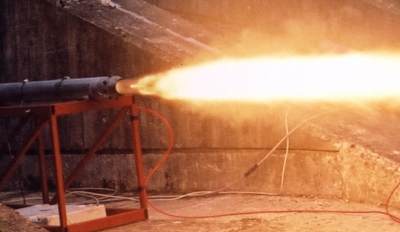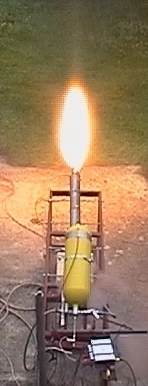B4 Hybrid Rocket Motor
The MARS B4 hybrid rocket motor was the single largest step in the MARS propulsion programme, and will pave the way for the impending space launch capability. Originally conceived in 1998, after the first flight of the smaller MARS BK Flamer hybrid rocket motor, the B4 motor was designed from the start as the reuseable, first stage rocket motor for the Deimos 3 two-stage space launcher. An original static test version of the B4 rocket motor was manufactured from stainless steel, with a second version manufactured from aluminium incorporated into the original Deimos 2 rocket, before it was displayed at the 'Tomorrow's World Live' show at London's Earls Court in 1999.
The B4 was planned to be tested in the minimum diameter Deimos Odyssey rocket to be launched from the Black Rock Desert in Nevada in September 2001, however, due to the terrorist attacks on the U.S., the project was held over for a UK test launch of the motor in the new Deimos 2 vehicle in a remote part of Scotland in November 2001.
The flight was a stunning success, with the down-rated B4 hybrid rocket motor delivering over 140kg (1400 Newtons) of average thrust lifting the rocket to well over a mile in altitude.
The B4 hybrid rocket motor is now undergoing static testing to ensure smooth operation up to its original design average thrust of 300kg (3000 Newtons). It has demonstrated reuseability already (with the only component needing replacement between test firings being the fuel!), and has been cold flow tested. The stunning success of the B4 hybrid rocket motor and the ground support equipment MARS has developed for it, are now being used to help with the development of the larger MARS hybrid rocket propulsion systems.


 The upper image shown is the first spectral image obtained from the spectrometer measuring the B4 hybrid rocket exhaust plume on its first static test firing. The lower image shows the spectral image from the calibration source. Subsequent refinements are improving the quality all the time, however, there is nothing like a first image of data such as this!
The upper image shown is the first spectral image obtained from the spectrometer measuring the B4 hybrid rocket exhaust plume on its first static test firing. The lower image shows the spectral image from the calibration source. Subsequent refinements are improving the quality all the time, however, there is nothing like a first image of data such as this!
